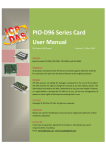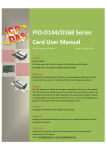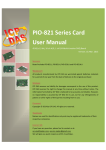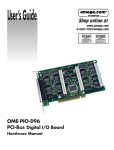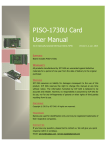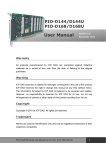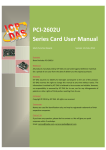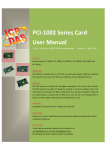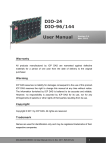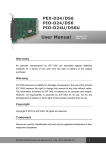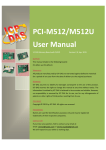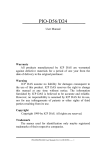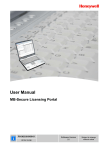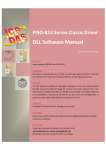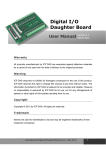Download PIO-D48 Series Card User Manual
Transcript
PIO-D48 Series Card User Manual 48-channel OPTO-22 compatible DIO board Version 3.4, Aug. 2015 SUPPORTS Board includes PIO-D48, PIO-D48U, PIO-D48SU and PEX-D48. WARRANTY All products manufactured by ICP DAS are warranted against defective materials for a period of one year from the date of delivery to the original purchaser. WARNING ICP DAS assumes no liability for damages consequent to the use of this product. ICP DAS reserves the right to change this manual at any time without notice. The information furnished by ICP DAS is believed to be accurate and reliable. However, no responsibility is assumed by ICP DAS for its use, nor for any infringements of patents or other rights of third parties resulting from its use. COPYRIGHT Copyright © 2013 by ICP DAS. All rights are reserved. TRADEMARK Names are used for identification only and may be registered trademarks of their respective companies. CONTACT US If you have any question, please feel to contact us. We will give you quick response within 2 workdays. Email: [email protected], [email protected] PIO-D48 Series Card 48-channel OPTO-22 Compatible DIO Board TABLE OF CONTENTS 1. INTRODUCTION ................................................................................................................................................. 3 1.1 PACKING LIST........................................................................................................................................................ 4 1.2 FEATURES .............................................................................................................................................................. 4 1.3 SPECIFICATIONS .................................................................................................................................................... 5 2. HARDWARE CONFIGURATION ............................................................................................................................ 6 2.1 BOARD L AYOUT .................................................................................................................................................... 6 2.2 I/O PORT LOCATION .............................................................................................................................................. 8 2.3 CARD ID SWITCH .................................................................................................................................................. 9 2.4 PIN ASSIGNMENTS............................................................................................................................................... 10 2.5 ENABLE I/O OPERATION ....................................................................................................................................... 12 2.6 D/I/O ARCHITECTURE.......................................................................................................................................... 13 2.7 INTERRUPT OPERATION ........................................................................................................................................ 14 2.7.1 Interrupt Block Diagram .............................................................................................................................. 15 2.7.2 INT_CHAN_0 ............................................................................................................................................... 16 2.7.3 INT_CHAN_1 ............................................................................................................................................... 17 2.7.4 INT_CHAN_2 ............................................................................................................................................... 18 2.7.5 INT_CHAN_3 ............................................................................................................................................... 19 3. HARDWARE INSTALLATION ...............................................................................................................................20 4. SOFTWARE INSTALLATION ................................................................................................................................24 4.1 OBTAINING/INSTALLING THE DRIVER INSTALLER PACKAGE ......................................................................................... 24 4.2 PNP DRIVER INSTALLATION ................................................................................................................................... 25 4.3 VERIFYING THE INSTALLATION .................................................................................................................................. 26 4.3.1 How do I get into Windows Device Manager? ................................................................................................. 26 4.3.2 Check that the Installation ............................................................................................................................... 28 5. TESTING PIO-D48 SERIES CARD .........................................................................................................................29 5.1 SELF-TEST WIRING .............................................................................................................................................. 29 5.2 EXECUTE THE TEST PROGRAM ................................................................................................................................ 31 6. I/O CONTROL REGISTER ....................................................................................................................................33 6.1 HOW TO FIND THE I/O ADDRESS ............................................................................................................................ 33 6.2 THE ASSIGNMENT OF I/O ADDRESS ........................................................................................................................ 35 6.3 THE I/O ADDRESS MAP ....................................................................................................................................... 37 User Manual/Ver. 3.4/Aug. 2015/PMH-006-34/Page: 1 PIO-D48 Series Card 48-channel OPTO-22 Compatible DIO Board 6.3.1 RESET\ Control Register............................................................................................................................... 38 6.3.2 INT Mask Control Register ................................................................................................................................ 38 6.3.3 Aux Status Register ........................................................................................................................................... 39 6.3.4 Interrupt Polarity Register ................................................................................................................................ 40 6.3.5 Read/Write I/O Port .......................................................................................................................................... 41 6.3.6 Read/Write 8254 .............................................................................................................................................. 43 6.3.7 Read/Write Clock/Int Control Register ............................................................................................................. 45 6.3.8 Read Card ID Register ....................................................................................................................................... 45 7. DEMO PROGRAMS............................................................................................................................................46 7.1 DEMO PROGRAM FOR WINDOWS .......................................................................................................................... 46 7.2 DEMO PROGRAM FOR DOS .................................................................................................................................. 48 APPENDIX: DAUGHTER BOARD ....................................................................................................................................49 A1. DB-37, DN-37, DN-50 and DN-100 ...................................................................................................................... 49 A2. DB-8125............................................................................................................................................................... 50 A3. ADP-37/PCI and ADP-50/PCI ............................................................................................................................... 50 A4. DB-24P and DB-24PD Isolated Input Board ......................................................................................................... 51 A5. DB-24R and DB-24RD Relay Board ...................................................................................................................... 52 A6. Daughter Boards Comparison Table .................................................................................................................... 53 User Manual/Ver. 3.4/Aug. 2015/PMH-006-34/Page: 2 PIO-D48 Series Card 48-channel OPTO-22 Compatible DIO Board 1. Introduction The PIO-D48U/D48SU and PEX-D48 is the new generation product that ICP DAS provides to meet RoHS compliance requirement and is designed as completely compatible with the PIO-D48. Users can replace the PIO-D48 by the PIO-D48U/PIO-D48SU/PEX-D48 directly without software/driver modification. The PIO-D48U/D48SU supports 3.3 V/5 V PCI bus, while the PEX-D48 supports PCI Express bus. These cards provide 48 TTL digital I/O lines, and these lines are grouped into six 8-bit bi-direction ports. Every three 8-bit ports are grouped as port A (PA), port B (PB) and port C (PC) on a connector, and the port C can be split into 2 nibble-wide(4-bit) parts. All ports are configured as inputs upon power-up or reset. The PIO-D48U/D48SU and PEX-D48 also adds a Card ID switch and pull-high/ pull-low resisters for DI on board. Users can set Card ID on a board and recognize the board by the ID via software when using two or more PIO-D48U/PIO-D48SU/PEX-D48 cards in one computer. The pull-high/ pull-low resisters allow the DI status to be specified when the DI channels are unconnected; the DI status will remain in high or low status other than floating. These cards support various OS such as Linux, DOS, Windows 98, Windows 2000, Windows NT, 32-/64-bit Windows XP/2003/2008/Vista/7 and Windows 8. It also provides the DLL and Active X control, and various language sample programs in Turbo C++, Borland c++, Microsoft C++, Visual C++, Borland Delphi, Borland C++ Builder, Visual Basic, C#.NET, Visual Basic.NET and LabVIEW to help users to quickly and easily develop their applications. User Manual/Ver. 3.4/Aug. 2015/PMH-006-34/Page: 3 PIO-D48 Series Card 48-channel OPTO-22 Compatible DIO Board 1.1 Packing List The shipping package includes the following items: One PIO-D48 series card hardware One printed Quick Start Guide One software utility CD Quick Start Note: If any of these items is missing or damaged, contact the dealer from whom you purchased the product. Save the shipping materials and carton in case you want to ship or store the product in the future. 1.2 Features Support the +5V PCI bus for PIO-D48 Support the +3.3/+5 V PCI bus for PIO-D48U/D48SU Supports PCI Express x 1 for PEX-D48 48 channels of digital I/O Bi-direction programmable I/O ports under software control All I/O lines buffered on the board Six 8-bit bi-direction I/O ports Connects directly to DB-24PR, DB-24PD, DB-24RD, DB-24PRD, DB-16P8R, DB-24POR, DB-24SSR, DB-24C or any OPTO-22 Compatible daughter boards PIO-D48(U)/PEX-D48: One DB37 connector and one 50-pin box headers PIO-D48SU: One SCSI II 100-pin connector Interrupt source 4-channel Card ID function for PIO-D48U/PIO-D48SU/PEX-D48 One 16-bit event counter and one 32-bit programmable internal timer Emulate two industrial-standard 8255 mode 0 Buffer output for higher driving capability than 8255 PIO-D48(U)/D48SU:DIO response time is about 1 μs (1 MHz) PEX-D48: DIO response time is about 500 kHz. SMD, short card, power saving User Manual/Ver. 3.4/Aug. 2015/PMH-006-34/Page: 4 PIO-D48 Series Card 48-channel OPTO-22 Compatible DIO Board 1.3 Specifications Model Name PIO-D48 PIO-D48U PIO-D48SU PEX-D48 Programmable Digital I/O Channels 48 Digital Input Compatibility 5 V/TTL Logic 0: 0.8 V max. Input Voltage Logic 1: 2.0 V min. Response Speed 1 MHz 500 KHz Digital Output Compatibility 5 V/TTL Logic 0: 0.4 V max. Output Voltage Logic 1: 2.4 V min. Sink: 64mA @ 0.8 V Output Capability Source: 32 mA @ 2.0 V Response Speed 1 MHz 500 KHz General Bus Type 5 V PCI, 32-bit, 3.3 V/5 V Universal PCI, 32-bit, 33 33 MHz MHz Data Bus Card ID I/O Connector Dimensions (L x W x D) Power Consumption Operating Temperature Storage Temperature Humidity PCI Express x1 8-bit No Yes(4-bit) Female DB37 x 1 Female SCSI II 50-pin box header x 1 100 pin x 1 156 mm x 105 mm x 22mm Female DB37 x 1 50-pin box header x 1 140 mm x 97 172 mm x 112 mm mm x 22 mm x 22 mm 900 mA @ +5 V 0 ~ 60 °C -20 ~ 70 °C 5 ~ 85% RH, non-condensing User Manual/Ver. 3.4/Aug. 2015/PMH-006-34/Page: 5 PIO-D48 Series Card 48-channel OPTO-22 Compatible DIO Board 2. Hardware Configuration 2.1 Board Layout The board layout of the PIO-D48/D48U cards are shown below: 1 PIO-D48 PIO-D48U Pull-High Only for PIO-D48U 1 2 Pull-High 1 Pull-High 3 3 Pull-Low Pull-High 2 2 JP7 (Port5) Pull-Low 1 1 Pull-High 3 3 Pull-Low 2 JP6 (Port4) 50-pin Pull-Low CN2 3 Pull-High 2 JP3 (Port1) JP5 (Port3) 1 2 3 4 1 CN1 DB-37 JP4 (Port2) Pull-Low SW1 2 3 JP2 (Port0) Pull-Low The board layout of the PEX-D48 cards are shown below: 1 Pull-High SW1 Pull-High Pull-Low 1 1 Pull-High 2 2 3 3 Pull-Low JP7 (Port5) 3 3 Pull-High 2 2 Pull-Low JP6 (Port4) 50-pin 1 1 CN1 DB-37 JP3 (Port1) Pull-High CN2 Pull-Low 1 2 3 4 JP4 (Port0) Pull-High 3 3 Pull-Low JP5 (Port3) 2 2 JP2 (Port2) 1 PEX-D48 Pull-Low Note: Default Setting: JP2/3/4/5/6/7=2-3 short = Pull-Low User Manual/Ver. 3.4/Aug. 2015/PMH-006-34/Page: 6 PIO-D48 Series Card 48-channel OPTO-22 Compatible DIO Board 2 3 2 3 1 2 3 1 2 3 1 2 3 1 2 3 Pull-Low Pull-Low Pull-Low Pull-Low 1 Pull-Low 1 Pull-Low Pull-High CON1 SCSI II 100-pin JP2 (Port0) Pull-High Pull-High Pull-High Pull-High Pull-High The board layout of the PIO-D48SU cards are shown below: JP7 (Port5) JP6 (Port4) SW1 1 2 3 4 JP5 (Port3) JP3 (Port2) JP4 (Port1) PIO-D48SU Note: Default Setting: JP2/3/4/5/6/7=2-3 short = Pull-Low User Manual/Ver. 3.4/Aug. 2015/PMH-006-34/Page: 7 PIO-D48 Series Card 48-channel OPTO-22 Compatible DIO Board 2.2 I/O Port Location There are six 8-bit I/O ports in the PIO-D48 series cards. Each I/O port can be programmed as a D/I or D/O port. When the PC is first powered-on or reset, all the ports are configured as D/I ports. These D/I ports can be selected to either pull-high or pull-low via placement of the JP2 to JP7 jumpers. These I/O port locations are given as follows: Connector of PIO-D48/D48U CN1 (DB37) CN2 (50-pin) PA0 ~ PA7 Port0 (pull-high/low by JP2) Port3 (pull-high/low by JP5) PB0 ~ PB7 Port1 (pull-high/low by JP3) Port4 (pull-high/low by JP6) PC0 ~ PC7 Port2 (pull-high/low by JP4) Port5 (pull-high/low by JP7) CN1 (DB37) CN2 (50-pin) PA0 ~ PA7 Port0 (pull-high/low by JP4) Port3 (pull-high/low by JP5) PB0 ~ PB7 Port1 (pull-high/low by JP3) Port4 (pull-high/low by JP6) PC0 ~ PC7 Port2 (pull-high/low by JP2) Port5 (pull-high/low by JP7) Connector of PEX-D48 Connector of PIO-D48SU CON1 (SCSI 100-pin) PA00 ~ PA07 Port0 (pull-high/low by JP2) PB00 ~ PB07 Port1 (pull-high/low by JP3) PC00 ~ PC07 Port2 (pull-high/low by JP4) PA10 ~ PA17 Port3 (pull-high/low by JP5) PB10 ~ PB17 Port4 (pull-high/low by JP6) PC10 ~ PC17 Port5 (pull-high/low by JP7) Note: Refer to Sec. 2.1 for the I/O port locations and JP2~JP7 pull-high/low placements on the board layout. User Manual/Ver. 3.4/Aug. 2015/PMH-006-34/Page: 8 PIO-D48 Series Card 48-channel OPTO-22 Compatible DIO Board 2.3 Card ID Switch The PIO-D48U, PIO-D48SU and PEX-D48 has a Card ID switch (SW1) with which users can recognize the board by the ID via software when using two or more PIO-D48(S)U and PEX-D48 cards in one computer. The default Card ID is 0x0. For detail SW1 Card ID settings, please refer to Table 2.1. NO ID 2 ID 3 ID 1 ID 0 SW1 1 2 3 4 (Default Settings) (*) Default Settings; OFF 1; ON 0 1 2 Card ID (Hex) ID0 ID1 Table 2.1 3 ID2 4 ID3 (*) 0x0 ON ON ON ON 0x1 OFF ON ON ON 0x2 ON OFF ON ON 0x3 OFF OFF ON ON 0x4 ON ON OFF ON 0x5 OFF ON OFF ON 0x6 ON OFF OFF ON 0x7 OFF OFF OFF ON 0x8 ON ON ON OFF 0x9 OFF ON ON OFF 0xA ON OFF ON OFF 0xB OFF OFF ON OFF 0xC ON ON OFF OFF 0xD OFF ON OFF OFF 0xE ON OFF OFF OFF 0xF OFF OFF OFF OFF User Manual/Ver. 3.4/Aug. 2015/PMH-006-34/Page: 9 PIO-D48 Series Card 48-channel OPTO-22 Compatible DIO Board 2.4 Pin Assignments The Pin assignments for all connectors on the PIO-D48/D48U/D48SU and PEX-D48 are represented in Figure 2-1 and Figure 2-2. All signal sources for each digital input or output pin (channel) is TTL compatible. Pin Assignments of the PIO-D48/D48U and PEX-D48: CN1: 37-pin D-type female connector (for Port0, Port1, Port2). CN2: 50-pin flat-cable connector (for Port3, Port4, Port5). Figure 2-1 User Manual/Ver. 3.4/Aug. 2015/PMH-006-34/Page: 10 PIO-D48 Series Card 48-channel OPTO-22 Compatible DIO Board Pin Assignments of the PIO-D48SU: CON1: 100-pin SCSI connector (for Port0~ Port5). Figure 2-2 User Manual/Ver. 3.4/Aug. 2015/PMH-006-34/Page: 11 PIO-D48 Series Card 48-channel OPTO-22 Compatible DIO Board 2.5 Enable I/O Operation When the PC is first turned on, all operations involved with digital I/O channels are disabled. Note that the digital I/O channel of each port is enabled or disabled by the RESET\ signal (Refer to Sec. 6.3.1 for more information related to this). The power-on states are given as follows: D/I/O operations for each port are disabled. D/I/O ports are all configured as Digital input ports. D/O latch register outputs are all high impedance. (Refer to Sec. 2.6) The user has to perform some initialization before using these digital I/O ports. The recommended steps are given below: Step 1: Find the address-mapping for PIO/PISO cards. (Refer to Sec.6.1) Step 2: Enable all Digital I/O operations. (Refer to Sec. 6.3.1). Step 3: Configure ports to their expected D/I/O state & send their initial values to every D/O port (Refer to Sec. 6.3.7) For more information on the initial procedure for digital I/O ports, please refer to the DIO demo program. User Manual/Ver. 3.4/Aug. 2015/PMH-006-34/Page: 12 PIO-D48 Series Card 48-channel OPTO-22 Compatible DIO Board 2.6 D/I/O Architecture The digital I/O control architecture for the PIO-D48/D48U/D48SU and PEX-D48 are demonstrated in Figure 2.3. The operation method used for the control signal is presented below. RESET\ is in the Low-state all D/I/O operation is disabled RESET\ is in the High-state all D/I/O operation is enabled. If D/I/O is configured as a D/I port D/I= external input signal. DI ports can be configured as either pull-high or pull-low by setting the JP2/3/4/5/6/7 jumpers (shorted 1-2=pull-high; shorted 2-3= pull-low). If D/I/O is configured as a D/O port D/I = read back D/O. If D/I/O is configured as D/I port sending data to a digital input port will only change the D/O latch register. The latched data will be output when the port is configured as digital output and is activated right away. RESET\ (Sec. 6.3.1) I/O Select (Sec. 6.3.7) Disable\ Data Input Sec. 6.3.8 D/I/O Latch Clock Input D/O Latch CKT Disable Data Sec. 6.3.8 Buffer Input 10 K Clock Input 1 Figure 2-3 D/I Buffer CKT 2 3 Vcc (Pull-high) GND (Pull-Low) JP2/3/4/5/6/7 pull-high/pull-low select (Default: all JPx are in 2-3 short, selection pull-low) User Manual/Ver. 3.4/Aug. 2015/PMH-006-34/Page: 13 PIO-D48 Series Card 48-channel OPTO-22 Compatible DIO Board 2.7 Interrupt Operation There are four interrupt sources in the PIO-D48/D48U/D48SU and PEX-D48. These four signals are named INT_CHAN_0, INT_CHAN_1, INT_CHAN_2 and INT_CHAN_3. Their signal sources are given as follows: INT_CHAN_0: PC3/PC7 from port-2 (Refer to Sec. 2.7.2) INT_CHAN_1: PC3/PC7 from port-5 (Refer to Sec. 2.7.3) INT_CHAN_2: Cout0 (Refer to Sec. 2.7.4) INT_CHAN_3: Cout2 (Refer to Sec. 2.7.5) Note that DEMO4.C, DEMO7.C, DEMO8.C, DEMO9.C and DEMO10.C are demo programs for a single interrupt source and DEMO11.C is the demo program for more than one interrupt source in the DOS operating system. If only one interrupt signal source is used, the interrupt service routine does not need to identify the interrupt source. However, if there are more than one interrupt source, the interrupt service routine has to identify the active signals in the following manner: 1. Read the new status of all interrupt signal sources. (refer to Sec 6.3.5) 2. Compare the new status with the old status to identify the active signals. 3. If INT_CHAN_0 is active, service INT_CHAN_0 & non-inverter/inverted the INT_CHAN_0 signal. 4. If INT_CHAN_1 is active, service INT_CHAN_1 & non-inverted/inverted the INT_CHAN_1 signal. 5. If INT_CHAN_2 is active, service INT_CHAN_2 & non-inverted/inverted the INT_CHAN_2 signal. 6. If INT_CHAN_3 is active, service INT_CHAN_3 & non-inverted/inverted the INT_CHAN_3 signal. 7. Update the interrupt status. Limitation!! If the interrupt signal is too short, the new status may be the same as the old status. So the interrupt signal must be held active until the interrupt service routine has been executed. This hold time is different for differing operating systems. The hold time can be as short as a micro-second or as long as 1 second. In general, 20 ms is enough for all O.S. User Manual/Ver. 3.4/Aug. 2015/PMH-006-34/Page: 14 PIO-D48 Series Card 48-channel OPTO-22 Compatible DIO Board 2.7.1 Interrupt Block Diagram Figure 2-4 The INT\ interrupt output signals are level-trigger and Active_Low. If the INT\ generates a low-pulse, the PIO-D48 series cards will interrupt the PC once per occasion. If the INT\ is fixed in low level, the PIO-D48 series cards will interrupt the PC continuously. So the INT_CHAN_0/1/2/3 must be controlled with pulse_type signals. They should normally be fixed in a low level state and generate a high_pulse to interrupt the PC. The priority of INT_CHAN_0/1/2/3 is the same. If all these four signals are active at the same time, then INT\ will be active only once per occasion. So the interrupt service routine has to read the status for all interrupt channels for multi-channel interruptions. (Refer to Sec. 2.7 for more information). Operating System: DOS DEMO11.C For both INT_CHAN_0 & INT_CHAN_1 If only one interrupt source is used, the interrupt service routine doesn’t have to read the interrupt source status. Note that DEMO4.C to DEMO10.C is demo programs for a single-channel interruption within the DOS operating system. Operating System: DOS DEMO4.C DEMO7.C DEMO8.C DEMO9.C DEMO10.C For INT_CHAN_3 only For INT_CHAN_2 only For INT_CHAN_0 only For INT_CHAN_0 only For INT_CHAN_1 only User Manual/Ver. 3.4/Aug. 2015/PMH-006-34/Page: 15 PIO-D48 Series Card 48-channel OPTO-22 Compatible DIO Board 2.7.2 INT_CHAN_0 Figure 2-5 NT_CHAN_0 should normally be fixed in a low level state and generate a high_pulse to interrupt the PC. INT_CHAN_0 can be equal to PC3&!PC7 or be PC3 programmable as is shown below : (Refer to Sec. 6.3.9) CTRL_D3=0, CTRL_D2=1 INT_CHAN_0= Disable CTRL_D3=1, CTRL_D2=0 INT_CHAN_0= PC3 of port-2 CTRL_D3=0, CTRL_D2=0 INT_CHAN_0= PC3&!PC7 of port-2 EN0 can be used to enable/disable the INT_CHAN_0 as follows: (Refer to Sec. 6.3.4) EN0=0 INT_CHAN_0=Disabled EN0=1 INT_CHAN_0=Enabled INV0 can be used to invert/non-invert the PC3 or PC3&!PC7 as follows: (Refer to Sec. 6.3.6) INV0=0 INT_CHAN_0=inverted state of (PC3 or PC3&!PC7 of port-2) INV0=1 INT_CHAN_0=non-inverted state of (PC3 or PC3&!PC7 of port-2) Refer to the following demo programs for more information: Operating System: DOS DEMO8.C DEMO9.C For INT_CHAN_0 only (PC3 of Port-2) For INT_CHAN_0 only (PC3&!PC7 of Port-2) User Manual/Ver. 3.4/Aug. 2015/PMH-006-34/Page: 16 PIO-D48 Series Card 48-channel OPTO-22 Compatible DIO Board 2.7.3 INT_CHAN_1 Figure 2-6 INT_CHAN_1 should normally be fixed in low level state and generate a high_pulse to interrupt the PC. INT_CHAN_1 can be equal to PC3&!PC7 or be PC3 programmable as is shown below:(Refer to Sec. 6.3.9) CTRL_D5=0, CTRL_D4=1 INT_CHAN_1= Disabled CTRL_D5=1, CTRL_D4=0 INT_CHAN_1= PC3 of port-5 CTRL_D5=0, CTRL_D4=0 INT_CHAN_1= PC3&!PC7 of port-5 EN1 can be used to enable/disable the INT_CHAN_1 as follows: (Refer to Sec. 6.3.4) EN1=0 INT_CHAN_1= Disabled EN1=1 INT_CHAN_1= Enabled INV1 can be used to invert/non-invert the PC3 or PC3&!PC7 as follows: (Refer to Sec. 6.3.6) INV1=0 INT_CHAN_1=inverted state of (PC3 or PC3&!PC7 of port-5) INV1=1 INT_CHAN_1=non-inverted state of (PC3 or PC3&!PC7 of port-5) Refer to the following demo program for more information: Operating System: DOS DEMO10.C For INT_CHAN_1 only (PC3&!PC7 of Port-5) Note: Refer to Sec. 2.7.2 for active high-pulse generation. User Manual/Ver. 3.4/Aug. 2015/PMH-006-34/Page: 17 PIO-D48 Series Card 48-channel OPTO-22 Compatible DIO Board 2.7.4 INT_CHAN_2 Figure 2-7 INT_CHAN_2 should normally be fixed in a low-level state and generate a high_pulse to interrupt the PC. PC0 (Port-2) can be inverted/non-inverted programmable as is shown below: (Refer to Sec. 6.3.9) CTRL_D1=0 Cin0=PC0 of Port-2 CTRL_D1=1 Cin0=!PC0 of Port-2 EN2 can be used to enable/disable the INT_CHAN_2 as follows: (Refer to Sec. 6.3.4) EN2=0 INT_CHAN_2=disabled EN2=1 INT_CHAN_2=enabled INV2 can be used to invert/non-invert the Cout0 as follows: (Refer to Sec. 6.3.6) INV2=0 INT_CHAN_2=inverted state of (Cout0) INV2=1 INT_CHAN_2=non-inverted state of (Cout0) Refer to the following demo program for more information: Operating System: DOS DEMO7.C For INT_CHAN_2 only (Cout0) Note: Refer to Sec. 2.7.2 for active high-pulse generation. User Manual/Ver. 3.4/Aug. 2015/PMH-006-34/Page: 18 PIO-D48 Series Card 48-channel OPTO-22 Compatible DIO Board 2.7.5 INT_CHAN_3 Figure 2-8 INT_CHAN_3 should normally be fixed in a low-level state and generate a high_pulse to interrupt the PC. Cin1 can be 2M/32768Hz programmable as is given below: (Refer to Sec. 6.3.9) CTRL_D0=0 Cin1=2 M clock source CTRL_D0=1 Cin1=32768 Hz clock source EN3 can be used to enable/disable the INT_CHAN_3 as follows: (Refer to Sec. 6.3.4) EN3=0 INT_CHAN_3= Disabled EN3=1 INT_CHAN_3= Enabled INV3 can be used to invert/non-invert the Cout0 as follows: (Refer to Sec. 6.3.6) INV2=3 INT_CHAN_3=invert (Cout2) INV2=3 INT_CHAN_3=non-invert (Cout2) Refer to the following demo program for more information: Operating System: DOS DEMO4.C For INT_CHAN_3 only (Cout2) Note: Refer to Sec. 2.7.2 for active high-pulse generation. User Manual/Ver. 3.4/Aug. 2015/PMH-006-34/Page: 19 PIO-D48 Series Card 48-channel OPTO-22 Compatible DIO Board 3. Hardware Installation Note: As certain operating systems, such as Windows 2000/XP may require the computer to be restarted after a new driver is installed, it is recommended that the driver is installed first, which will reduce the installation time. To install your PIO-D48 series card, complete the following steps: Step 1: Installing PIO-D48 series card driver on your computer first. For detailed information about the driver installation, please refer to Chapter 4 Software Installation. Step 2: Configuring Card ID by the SW1 DIP-Switch. For detailed information about the card ID (SW1), please refer to Sec. 2.3 Car ID Switch . User Manual/Ver. 3.4/Aug. 2015/PMH-006-34/Page: 20 PIO-D48 Series Card 48-channel OPTO-22 Compatible DIO Board Step 3: Shut down and power off your computer. Step 4: Remove all covers from the computer. Step 5: Select an empty PCI/PCI Express slot. User Manual/Ver. 3.4/Aug. 2015/PMH-006-34/Page: 21 PIO-D48 Series Card 48-channel OPTO-22 Compatible DIO Board Step 6: Remove the PCI/PCI Express slot cover form the PC. Step 7: Remove the connector cover form the PIO-D48 series card. Step 8: Carefully insert your PIO-D48 series card into the PCI/PCI Express slot. PIO-D48 PIO-D48U PIO-D48SU PEX-D48 User Manual/Ver. 3.4/Aug. 2015/PMH-006-34/Page: 22 PIO-D48 Series Card 48-channel OPTO-22 Compatible DIO Board Step 9: Tighten the captive Phillips screw. Confirm the PIO-D48 series card is mounted on the motherboard. Step 10: Replace the computer cover. Step 11: Power on the computer. Follow the prompt message to finish the Plug&Play steps, please refer to Chapter 4 Software Installation. User Manual/Ver. 3.4/Aug. 2015/PMH-006-34/Page: 23 PIO-D48 Series Card 48-channel OPTO-22 Compatible DIO Board 4. Software Installation This chapter provides a detailed description of the process for installing the PIO-D48 series driver and how to verify whether the PIO-D48 was properly installed. PIO-D48 series card can be used on DOS, Linux and Windows 98/ME/2000 and 32-/64-bit XP/2003/Vista/7/8 based systems, and the drivers are fully Plug &Play (PnP) compliant for easy installation. 4.1 Obtaining/Installing the Driver Installer Package The driver installer package for the PIO-D48 series card can be found on the supplied CD-ROM, or can be obtained from the ICP DAS FTP web site. Install the appropriate driver for your operating system. The location and addresses are indicated in the Table4-1 and Table4-2 below. Table 4-1: UniDAQ Driver/SDK OS Windows 2000、32/64-bit Windows XP、32/64-bit Windows 2003、 32/64-bit Windows Vista、32/64-bit Windows 7、32/64-bit Windows 2008、 32/64-bit Windows 8 Driver Name UniDAQ Driver/SDK (unidaq_win_setup_xxxx.exe) CD-ROM CD:\\ NAPDOS\PCI\UniDAQ\DLL\Driver\ Web Site http://ftp.icpdas.com/pub/cd/iocard/pci/napdos/pci/unidaq/dll/driver/ Installing Procedure For detailed information about the UniDAQ driver installation, please refer to UniDAQ DLL Software Manual. The user manual is contained in: CD:\NAPDOS\PCI\UniDAQ\Manual\ http://ftp.icpdas.com/pub/cd/iocard/pci/napdos/pci/unidaq/manual/ User Manual/Ver. 3.4/Aug. 2015/PMH-006-34/Page: 24 PIO-D48 Series Card 48-channel OPTO-22 Compatible DIO Board Table 4-2: PIO-DIO Series Classic Driver OS Windows 95/98/ME、Windows NT、Windows 2000、32-bit Windows XP、 32-bit Windows 2003、32-bit Windows Vista、32-bit Windows 7 Driver Name PIO-DIO Series Classic Driver(PIO_DIO_Win__vxxx.exe) CD-ROM CD:\\ NAPDOS\PCI\PISO-DIO\DLL_OCX\Driver\ Web Site http://ftp.icpdas.com/pub/cd/iocard/pci/napdos/pci/pio-dio/dll_ocx/driver/ Installing For detailed information about the PIO-DIO series classic driver installation, please refer to PIO-DIO series classic driver DLL Software Manual. The user manual is contained in: CD:\NAPDOS\PCI\PISO-DIO\Manual\ Procedure http://ftp.icpdas.com/pub/cd/iocard/pci/napdos/pci/pio-dio/dll_ocx/driver/ 4.2 PnP Driver Installation Power off the computer and install the PIO-D48 series cards. Turn on the computer and Windows 95/98/ME/NT/2000 and 32-/64-bit Windows XP/2003/Vista/7/8 should automatically defect the new PCI device(s) and then ask for the location of the driver files for the hardware. If a problem is encountered during installation, refer to the PnPinstall.pdf file for more information. User Manual/Ver. 3.4/Aug. 2015/PMH-006-34/Page: 25 PIO-D48 Series Card 48-channel OPTO-22 Compatible DIO Board 4.3 Verifying the Installation To verify the installation, use the Windows Device Manager to view and update the device drivers installed on your computer, and check to ensure that hardware is operating correctly. The following is a description of how access the Device Manager in each of the major versions of Windows. Refer to the appropriate description for your specific operating system to verify the installation. 4.3.1 How do I get into Windows Device Manager? Microsoft Windows 95/98/ME Step 1: On the desktop right-click on “My Computer” and click “Properties” or open the “Control Panel” and double-click the “System” icon. Step 2: Click the “Device Manager” tab. Microsoft Windows 2000/XP Step 1: Click “Start” then point to “Settings” and click “Control Panel”. Double-click the “System” icon to open the “System Properties” dialog box.. Step 2: Click the “Hardware” tab and then click the “Device Manager” button. Microsoft Windows 2003 Step 1: Click “Start” point to “Administrative Tools”, and then click “Computer Management”. Step 2: From “System Tools” in the console tree, click “Device Manager”. User Manual/Ver. 3.4/Aug. 2015/PMH-006-34/Page: 26 PIO-D48 Series Card 48-channel OPTO-22 Compatible DIO Board Microsoft Windows Vista/7 Step 1: Click “Start” button, and then click “Control Panel”. Step 2: Click “System and Maintenance”, and then click “Device Manager”. Alternatively, Step 1: Click “Start” button. Step 2: In the Search field, type Device Manager and the press Enter. Note that Administrator privileges are required for this operation. If you are prompted for an administrator password or confirmation, type the password or provide confirmation. Microsoft Windows 8 Step 1: To display the Start screen icon from the desktop view, simply hover the mouse cursor over the bottom-left corner of screen. Step 2: Right-click the Start screen icon then click “Device Manager”. Alternatively, press [Windows Key] +[X] to open the Start Menu, and select Device Manager from the options list. Right-click User Manual/Ver. 3.4/Aug. 2015/PMH-006-34/Page: 27 PIO-D48 Series Card 48-channel OPTO-22 Compatible DIO Board 4.3.2 Check that the Installation Check the PIO-D48 series card which listed correctly or not, as illustrated below. Installation successful User Manual/Ver. 3.4/Aug. 2015/PMH-006-34/Page: 28 PIO-D48 Series Card 48-channel OPTO-22 Compatible DIO Board 5. Testing PIO-D48 Series Card This chapter can give you the detail steps about self-test. In this way, user can confirm that PIO-D48 series card well or not. Before the self-test, you must complete the hardware and driver installation. For detailed information about the hardware and driver installation, please refer to Chapter 3 Hardware Installation and Chapter 4 Software Installation. 5.1 Self-Test Wiring PIO-D48(U) and PEX-D48: 1. Use the DN-37 (optional) to connect the CN1 on the PIO-D48(U) or PEX-D48 card. PIO-D48/PIO-D48U PEX-D48 User Manual/Ver. 3.4/Aug. 2015/PMH-006-34/Page: 29 PIO-D48 Series Card 48-channel OPTO-22 Compatible DIO Board 2. Connect the Port0 (PA0 ~ PA7) with Port1 (PB0 ~ PB7). PIO-D48SU: 1. Use DN-100 wiring terminal board (optional) to connect the CON1 on the PIO-D48SU card. PIO-D48SU User Manual/Ver. 3.4/Aug. 2015/PMH-006-34/Page: 30 PIO-D48 Series Card 48-channel OPTO-22 Compatible DIO Board 2. Connect the Port0 (PA00 ~ PA07) with Port1 (PB00 ~ PB07). 5.2 Execute the Test Program The following example use UniDAQ driver to perform self-test. If you install the PIO-DIO series classic driver, please refer to Quick Start Guide of the PIO-D48 (http://ftp.icpdas.com/pub/cd/iocard/pci/napdos/pci/pio-dio/manual/quickstart/d48/pio-d48_quic kstart_eng.pdf) to execute the self-test. 3. Execute the UniDAQ Utility Program. The UniDAQ Utility.exe will be placed in the default path after completing installation. Click this button to start test. Default Path: C:\ICPDAS\UniDAQ\Driver\ 3 Double click the “UniDAQUtility.exe” Double-Click 1 2 Confirm the PIO-D48 series card had successfully installed to PC. It start s from 0. User Manual/Ver. 3.4/Aug. 2015/PMH-006-34/Page: 31 PIO-D48 Series Card 48-channel OPTO-22 Compatible DIO Board 4. Get DIO function test result. Click “Digital Output” item. 1 3 Check channel 0, 2, 4, 6 Select the “Port 1” 2 Click “Digital Input” item. 4 6 The corresponding D/I becomes black for channel 0, 2, 4, 6 of D/O is ON. Select the “Port 0” 5 User Manual/Ver. 3.4/Aug. 2015/PMH-006-34/Page: 32 PIO-D48 Series Card 48-channel OPTO-22 Compatible DIO Board 6. I/O Control Register 6.1 How to Find the I/O Address The plug&play BIOS will assign a proper I/O address to every PIO/PISO series card in the power-on stage. The fixed IDs for the PIO-D48 series cards are given as follows: Table 6-1: PIO-D48(U) (Rev 1.x) PIO-D48(U)/PEX-D48 (Rev 2.0 or above) Vendor ID 0xE159 Vendor ID 0xE159 Device ID 0x0002 Device ID 0x0001 Sub-Vendor ID 0x80 Sub-Vendor ID 0x0080 Sub-Device ID 0x01 Sub-Device ID 0x01 Sub-Aux ID 0x30 Sub-Aux ID 0x30 Table 6-2: PIO-D48SU (Rev 1.0 or above) Vendor ID 0xE159 Device ID 0x0001 Sub-Vendor ID 0x0080 Sub-Device ID 0x0001 Sub-Aux ID 0x0030 User Manual/Ver. 3.4/Aug. 2015/PMH-006-34/Page: 33 PIO-D48 Series Card 48-channel OPTO-22 Compatible DIO Board The PIO_PISO.EXE utility program will detect and present all information for PIO/PISO cards installed in the PC, as shown in the following Figure6-1. Details of how to identify the PIO-D48 series cards of ICPDAS data acquisition boards based on the Sub-vendor, Sub-device and Sub-Aux ID are given in Table 6-1 and 6-2. The PIO_PISO.exe utility is located on the CD as below and is useful for all PIO/PISO series cards. CD:\NAPDOS\PCI\Utility\Win32\PIO_PISO\ http://ftp.icpdas.com/pub/cd/iocard/pci/napdos/pci/utility/win32/pio_piso/ Figure 6-1: User Manual/Ver. 3.4/Aug. 2015/PMH-006-34/Page: 34 PIO-D48 Series Card 48-channel OPTO-22 Compatible DIO Board 6.2 The Assignment of I/O Address Use Card ID for new users. The Plug&Play BIOS will assign the proper I/O address to a PIO/PISO series card. If there is only one PIO/PISO board, the user can identify the board as card_0. If there are two PIO/PISO boards in the system, it is very difficult to identify which board is card_0. The software driver can support a maximum of 16 boards. Therefore, the user can install 16 PIO/PSIO series cards onto one PC system. The methods used to find and identify card_0 and card_1 is demonstrated below. The simplest way to identify which card is card_0 is to use wSlotBus and wSlotDevice in the following manner: Step 1: Remove all PIO-D48 series boards from the PC. Step 2: Install one PIO-D48 series onto the PC’s PCI_slot1, run PIO_PISO.EXE. Then record the wSlotBus1 and wSlotDevice1 information. Step 3: Remove all PIO-D48 series boards from the PC. Step 4: Install one PIO-D48 series into the PC’s PCI_slot2 and run PIO_PISO.EXE. Then record the wSlotBus2 and wSlotDevice2 information. Step 5: Repeat Steps(3) and (4) for every PCI_slot and record all information from wSlotBus and wSlotDevice. The records may look similar to the table follows: Table 6-3: PC’s PCI Slot wSlotBus wSlotDevice Slot_1 0 0x07 Slot_2 0 0x08 Slot_3 0 0x09 Slot_4 0 0x0A Slot_5 1 0x0A Slot_6 1 0x08 Slot_7 1 0x09 Slot_8 1 0x07 PCI-BRIDGE User Manual/Ver. 3.4/Aug. 2015/PMH-006-34/Page: 35 PIO-D48 Series Card 48-channel OPTO-22 Compatible DIO Board The above procedure will record all the wSlotBus and wSlotDevice information on a PC. These values will be mapped to this PC’s physical slot and this mapping will not be changed for any PIO/PISO cards. Therefore, this information can be used to identify the specified PIO/PISO card by following steps: Step1: Using the wSlotBus and wSlotDevice information from Table 6-3. Step2: Enter the board number into PIO_GetConfigAddressSpace(…) function to get the information for a specific card, especially the wSlotBus and wSlotDevice details. Step3: Identify the specific PIO/PISO card by comparing the data of the wSlotBus and wSlotDevice from Step1 and Step2. Note: that normally the card installed in slot 0 is card0 and the card installed in slot1 is card1 for PIO/PISO series cards. User Manual/Ver. 3.4/Aug. 2015/PMH-006-34/Page: 36 PIO-D48 Series Card 48-channel OPTO-22 Compatible DIO Board 6.3 The I/O Address Map The I/O address for PIO-D48 series cards are automatically assigned by the main board ROM BIOS. The I/O address may also be re-assigned by the user. It is strongly recommended that users do not change the I/O address. The Plug&Play BIOS will effectively perform the assignment of proper I/O addresses to each PIO-D48 series card. The I/O address for the PIO-D48/D48U/D48SU and PEX-D48 are given in the table below, all of which are based on the base address of each card. Table 6-4: Refer to Sec. 6.1 for more information about wBase. Address Read Write wBase+0 - RESET\ Control Register wBase+5 INT mask control register Same wBase+7 Aux pin status register Same wBase+0x2a INT polarity control register Same wBase+0xc0 Read Port0 (PA) Write Port0 (PA) wBase+0xc4 Read Port1 (PB) Write Port1 (PB) wBase+0xc8 Read Port2 (PC) Write Port2 (PC) wBase+0xcc - Write Control Word (Port 0/1/2) wBase+0xd0 Read Port3 (PA) Write Port3 (PA) wBase+0xd4 Read Port4 (PB) Write Port4 (PB) wBase+0xd8 Read Port5 (PC) Write Port5 (PC) wBase+0xdc - Write Control Word (Port 3/4/5) wBase+0xe0 Read 8254-Counter0 Write 8254-Counter0 wBase+0xe4 Read 8254-Counter1 Write 8254-Counter1 wbase+0xe8 Read 8254-Counter2 Write 8254-Counter2 wBase+0xec Read 8254 Control Word Writer 8254 Control Word wBase+0xf0 Read Clock/Int Control Word Write Clock/Int Control Word wBase+0xf4 Read Card ID - User Manual/Ver. 3.4/Aug. 2015/PMH-006-34/Page: 37 PIO-D48 Series Card 48-channel OPTO-22 Compatible DIO Board 6.3.1 RESET\ Control Register (Read/Write): wBase+0 Bit 7 Bit 6 Bit 5 Bit 4 Bit 3 Bit 2 Bit 1 Bit 0 Reserved Reserved Reserved Reserved Reserved Reserved Reserved RESET\ When the PC’s power is first turned on, RESET\ signal is in a Low-state. This will disable all D/I/O operations. The user has to set the RESET\ signal to a High-state before any D/I/O command applications are initiated. For example: outportb (wBase,1); /* RESET\=High all D/I/O are enable now */ outportb (wBase,0); /* RESET\=Low all D/I/O are disable now */ 6.3.2 INT Mask Control Register (Read/Write): wBase+5 Bit 7 Bit 6 Bit 5 Bit 4 Bit 3 Bit 2 Bit 1 Bit 0 0 0 0 0 EN3 EN2 EN1 EN0 EN0=0 Disable INT_CHAN_0 as an interrupt signal (Default). EN0=1 Enable INT_CHAN_0 as an interrupt signal EN1=0 disable INT_CHAN_1 as a interrupt signal (Default) EN1=1 enable INT_CHAN_1 as a interrupt signal EN2=0 disable INT_CHAN_2 as a interrupt signal (Default) EN2=1 enable INT_CHAN_2 as a interrupt signal EN3=0 disable INT_CHAN_3 as a interrupt signal (Default) EN3=1 enable INT_CHAN_3 as a interrupt signal User Manual/Ver. 3.4/Aug. 2015/PMH-006-34/Page: 38 PIO-D48 Series Card 48-channel OPTO-22 Compatible DIO Board For example: outportb(wBase+5,0); outportb(wBase+5,1); outportb(wBase+5,2); outportb(wBase+5,4); outportb(wBase+5,8); outportb(wBase+5,0x0f); /*Disable all interrupt */ /* Enable interrupt of INT_CHAN_0 */ /* Enable interrupt of INT_CHAN_1 */ /* Enable interrupt of INT_CHAN_2 */ /* Enable interrupt of INT_CHAN_3 */ /* Enable all four channels of interrupt */ 6.3.3 Aux Status Register (Read/Write): wBase+7 Bit 7 Bit 6 Bit 5 Bit 4 Bit 3 Bit 2 Bit 1 Bit 0 AuxID7 AuxID6 AuxID5 AuxID4 IntSate3 IntSate2 IntSate1 IntSate0 IntSate0 = INT_CHAN_0, IntSate1 = INT_CHAN_1, IntSate2 = INT_CHAN_2, IntSate3 = INT_CHAN_3, AuxID7 to 4 = Aux-ID. The IntSate0 to 3 are used as interrupt source. The interrupt service routine has to read this register to identify the interrupt source. Refer to Sec. 2.7 for more information. User Manual/Ver. 3.4/Aug. 2015/PMH-006-34/Page: 39 PIO-D48 Series Card 48-channel OPTO-22 Compatible DIO Board 6.3.4 Interrupt Polarity Register (Read/Write): wBase+0x2A Bit 7 Bit 6 Bit 5 Bit 4 Bit 3 Bit 2 Bit 1 Bit 0 0 0 0 0 INV3 INV2 INV1 INV0 This register provides a function to control invert or non-invert for the interrupt signal source. A detailed application example is given below. INV0=0 select the inverted signal from interrupt_channel_0 INV0=1 select the non-inverted signal from interrupt_channel_0 INV1= Control interrupt channel_1 INV2= Control interrupt channel_2 INV3= Control interrupt channel_3 For example: /* select the non-inverted input from all 4 channel */ outportb(wBase+0x2a,0x0f); /* select the inverted input from all 4 channel */ outportb(wBase+0x2a,0x00); /* select the inverted input of INT_CHAN_0 */ /* select the non-inverted input from the others */ outportb(wBase+0x2a,0x0e); /* select the inverted input of INT_CHAN_0& INT_CHAN_1 */ /* select the non-inverted input from the others */ outportb(wBase+0x2a,0x0c); Refer to Sec. 2.7 and DEMO5.C (DOS) for more information. User Manual/Ver. 3.4/Aug. 2015/PMH-006-34/Page: 40 PIO-D48 Series Card 48-channel OPTO-22 Compatible DIO Board 6.3.5 Read/Write I/O Port Control Word (Read/Write): wBase+0xcc/ 0xdc Bit 7 Bit 6 Bit 5 Bit 4 Bit 3 Bit 2 Bit 1 Bit 0 1 0 0 PA PC-H 0 PB PC-L These are six 8-bit I/O ports in the PIO-D48 series. Every I/O port can be programmed to be a D/I or a D/O port based on the control word settings. All six ports are configured as D/I ports when the power is first turned on. (Read/Write) wBase+0xcc = Set Input/Output mode for the port-0/1/2 (Read/Write) wBase+0xdc = Set Input/Output mode for the port-3/4/5 PA/PB/PC-H/PC-L: 1 Input port; 0 Output port PC-H: high nibble of PC PC-L: Low nibble of PC Read/Write 8-bit Data (Read/Write): wBase+0xc0/ 0xc4/ 0xc8/ 0xd0/ 0xd4/ 0xd8 Bit 7 Bit 6 Bit 5 Bit 4 Bit 3 Bit 2 Bit 1 Bit 0 D7 D6 D5 D4 D3 D2 D1 D0 (Read/Write) wBase+0xc0= Port-0 (PA) wBase+0xc4= Port-1 (PB) wBase+0xc8= Port-2 (PC) wBase+0xd0= Port-3 (PA) wBase+0xd4= Port-4 (PB) wBase+0xd8= Port-5 (PC) User Manual/Ver. 3.4/Aug. 2015/PMH-006-34/Page: 41 PIO-D48 Series Card 48-channel OPTO-22 Compatible DIO Board For example: outportb(wBase+0xcc,0x80); outportb(wBase+0xc0,V1); outportb(wBase+0xc4,V2); outportb(wBase+0xc8,V3); /* set output mode for the port-0/1/2 */ /* write to port_0 (PA) */ /* write to port_1 (PB) */ /* write to port_2 (PC) */ outportb(wBase+0xdc,0x9B); /* set input mode for the port-3/4/5 */ V1=inportb(wBase+0xd0); V2=inportb(wBase+0xd4); V3=inportb(wBase+0xd8); /* read from port_3 (PA) */ /* read from port_4 (PB) */ /* read from port_5 (PC) */ Note: The I/O speed is depending on I/O card, bus speed, CPU speed and system loading. Any condition changes may cause the I/O speed different. User Manual/Ver. 3.4/Aug. 2015/PMH-006-34/Page: 42 PIO-D48 Series Card 48-channel OPTO-22 Compatible DIO Board 6.3.6 Read/Write 8254 8254 Control Word (Read/Write): wBase+0xec Bit 7 Bit 6 Bit 5 Bit 4 Bit 3 Bit 2 Bit 1 Bit 0 SC1 SC0 RL1 RL0 M2 M1 M0 BCD BCD 0 Binary Count 1 BCD Count M2 M1 M0 0 0 0 Interrupt on terminal count 0 0 1 Programmable one-shot 0 1 0 Rate generator 0 1 1 Square-wave generator 1 0 0 software triggered pulse 1 0 1 Hardware triggered pulse RL1 RL0 0 0 Counter latch instruction 0 1 Read/write low counter byte only 1 0 Read/write high counter byte only 1 1 Read/write low counter byte first, then high counter SC1 SC0 0 0 Counter0 0 1 Counter1 1 0 Counter2 1 1 Readback command User Manual/Ver. 3.4/Aug. 2015/PMH-006-34/Page: 43 PIO-D48 Series Card 48-channel OPTO-22 Compatible DIO Board Read/Write 8-bit data of 8254 (Read/Write): wBase+0xe0/ 0xe4/ 0xe8 Bit 7 Bit 6 Bit 5 Bit 4 Bit 3 Bit 2 Bit 1 Bit 0 D7 D6 D5 D4 D3 D2 D1 D0 (Read/Write): wBase+0xec= 8254 control word (Read/Write): wBase+0xe0= 8254-counter-0 (Read/Write): wBase+0xe4= 8254-counter-1 (Read/Write): wBase+0xe8= 8254-counter-2 For example: outportb(wBase+0xec,0x30); outportb(wBase+0xe0,0xff); outportb(wBase+0xe0,0xff) /* Counter0, mode-0 */ /* write to low byte first */ /* write to high byte second */ /* Then Counter0 will down count from 0xffff */ The configuration of 8254 counter: 8254 Timer/Counter CLK0 INT_CHAN_2 OUT0 PC0 (Port-2) GATE0 Counter 0 CLK1 OUT1 GATE1 Counter 1 INT_CHAN_3 OUT2 32.768 KHz or 2 MHz VCC CLK2 GATE2 Counter 2 Refer to the following demo programs for more related information: Int2 Demo Counter0 (Using interrupt INT_CHAN_2) Int3 Demo Counter1 ~ Counter 2 (Using interrupt InT_CHAN_3) User Manual/Ver. 3.4/Aug. 2015/PMH-006-34/Page: 44 PIO-D48 Series Card 48-channel OPTO-22 Compatible DIO Board 6.3.7 Read/Write Clock/Int Control Register (Read/Write): wBase+0xf0 Bit 7 Bit 6 Bit 5 Bit 4 Bit 3 Bit 2 Bit 1 Bit 0 0 0 CTRL-D5 CTRL-D4 CTRL-D3 CTRL-D2 CTRL-D1 CTRL-D0 CTRL-D0: timer source CLK1 selection (Refer to Sec. 6.3.8) 0 2 MHz 1 32.768 KHz CTRL-D1: invert/non-invert the PC0 of port-2 (Refer to Sec. 2.7.4) 0 non-invert 1 invert CTRL-D3, CTRL-D2: interrupt source select (Refer to Sec. 2.7.2) 01 : disable PC3 & !PC7 (of port-2) as interrupt source 10 : INT_CHAN_0=PC3 of port-2 00 : INT_CHAN_0=PC3 & !PC7 of port-2 CTRL-D5, CTRL-D4: interrupt source select (refer to Sec. 2.7.3) 01 : disable PC3 & !PC7 (of port-5) as interrupt source 10 : INT_CHAN_1=PC3 of port-5 00 : INT_CHAN_1=PC3&!PC7 of port-5 6.3.8 Read Card ID Register (Read): wBase+0xf4 Bit 7 Bit 6 Bit 5 Bit 4 Bit 3 Bit 2 Bit 1 Bit 0 0 0 0 0 ID3 ID2 ID1 ID0 For example: wCardID=inportb(wBase+0xf4); /* Read Card ID */ Note: The Card ID function is only supported by the PIO-D48U/D48SU and PEX-D48 (Ver. 1.0 or above) User Manual/Ver. 3.4/Aug. 2015/PMH-006-34/Page: 45 PIO-D48 Series Card 48-channel OPTO-22 Compatible DIO Board 7. Demo Programs 7.1 Demo Program for Windows All demo programs will not work properly if the DLL driver has not been installed correctly. During the DLL driver installation process , the install-shields will register the correct kernel driver to the operation system and copy the DLL driver and demo programs to the correct position based on the driver software package you have selected (Win98/Me/NT/2K and 32-/64-bit Win XP/2003/Vista/7/8). Once driver installation is complete, the related demo programs and development library and declaration header files for different development environments will be presented as follows. Demo Program for PIO-DIO Series Classic Driver The demo program is contained in: CD:\NAPDOS\PCI\PIO-DIO\DLL_OCX\Demo\ http://ftp.icpdas.com/pub/cd/iocard/pci/napdos/pci/pio-dio/dll_ocx/demo/ BCB4 for Borland C++ Builder 4 PIODIO.H Header files PIODIO.LIB Linkage library for BCB only Delphi4 for Delphi 4 PIODIO.PAS Declaration files VC6 for Visual C++ 6 PIODIO.H Header files PIODIO.LIB Linkage library for VC only VB6 for Visual Basic 6 PIODIO.BAS Declaration files VB.NET2005 for VB.NET2005 PIODIO.vb Visual Basic Source files CSharp2005 for C#.NET2005 PIODIO.cs Visual C# Source files For detailed information about the DLL function of the PIO-D48 series, please refer to PIO-DIO DLL Software Manual (CD:\NAPDOS\PCI\PIO-DIO\Manual\) User Manual/Ver. 3.4/Aug. 2015/PMH-006-34/Page: 46 PIO-D48 Series Card 48-channel OPTO-22 Compatible DIO Board Demo Program for UniDAQ SDK Driver The demo program is contained in: CD:\NAPDOS\PCI\UniDAQ\DLL\Demo\ http://ftp.icpdas.com/pub/cd/iocard/pci/napdos/pci/unidaq/dll/demo/ BCB6 for Borland C++ Builder 6 UniDAQ.H Header files UniDAQ.LIB Linkage library for BCB only Delphi6 for Delphi 6 UniDAQ.PAS Declaration files VB6 for Visual Basic 6 UniDAQ.BAS Declaration files CSharp2005 for C#.NET2005 UniDAQ.cs Visual C# Source files VC6 for Visual C++ 6 UniDAQ.H Header files UniDAQ.LIB Linkage library for VC only VB.NET2005 for VB.NET2005 UniDAQ.vb Visual Basic Source files VC.NET2005 for VC.NET2005 (32-bit) UniDAQ.H Header files UniDAQ.LIB Linkage library for VC only VC.NET2005 for VC.NET2005 (64-bit) UniDAQ.H Header files UniDAQ.LIB Linkage library for VC only For detailed information about the DLL function and demo program of the UniDAQ, please refer to UniDAQ DLL Software Manual (CD:\NAPDOS\PCI\UniDAQ\Manual\) User Manual/Ver. 3.4/Aug. 2015/PMH-006-34/Page: 47 PIO-D48 Series Card 48-channel OPTO-22 Compatible DIO Board 7.2 Demo Program for DOS The demo program is contained in: CD:\NAPDOS\PCI\PIO-DIO\DOS\D48\PIOD48\ http://ftp.icpdas.com/pub/cd/iocard/pci/napdos/pci/pio-dio/dos/d48/piod48/ \TC\*.* for Turbo C 2.xx or above \MSC\*.* for MSC 5.xx or above \BC\*.* for BC 3.xx or above \TC\LIB\*.* for TC Library \TC\DEMO\*.* for TC demo program \TC\DIAG\*.* for TC diagnostic program \TC\LIB\PIO.H TC Declaration File \TC\LIB\TCPIO_L.LIB TC Large Model Library File \TC\LIB\TCPIO_H.LIB TC Huge Model Library File The list of demo programs: DEMO1: D/O Demo DEMO2: D/I Demo DEMO3: D/I/O Demo DEMO4: Timer Interrupt of INT_CHAN_3 DEMO5: Event Counter (no interrupt) of INT_CHAN_2 (init_HIGH & active_Low) DEMO6: Event Counter (no interrupt) of INT_CHAN_2 (init_Low & active_HIGH) DEMO7: Down-Counter (interrupt) of INT_CHAN_2 (init_HIGH & active_Low) DEMO8: Interrupt demo of INT_CHAN_0 (PC7 of Port2 don’t care) DEMO9: Interrupt demo of INT_CHAN_0 (PC7 of Port2 interrupt is enable) DEMO10: Interrupt demo of INT_CHAN_1 (PC7 of Port5 interrupt is disable) DEMO11: Interrupt demo of INT_CHAN_0 & INT_CHAN_1 For detailed information about the DLL function of the DOS, please refer to PIO-DIO DLL Software Manual (CD:\NAPDOS\PCI\PIO-DIO\Manual\) User Manual/Ver. 3.4/Aug. 2015/PMH-006-34/Page: 48 PIO-D48 Series Card 48-channel OPTO-22 Compatible DIO Board Appendix: Daughter Board A1. DB-37, DN-37, DN-50 and DN-100 DB-37: The DB-37 is a general purpose daughter board for D-sub 37 pins. It is designed for easy wire connection via pin-to-pin. Use a 37-pin cable (e.g. CA-3710 ,etc.) to connect DB-37 to CON1 of the PIO-D48(U)/PEX-D48. DB-37 DN-37 and DN-50: The DN-37 is a general purpose daughter board for DB-37 pins with DIN-Rail Mountings. The DN-50 is designed for 50-pin flat-cable headers win DIN-Rail mountings. They are also designed for easy DN-50 wire connection via pin-to-pin. Use a 37-pin cable (e.g. CA-3710 ,etc.) to connect to CN1 of the PIO-D48(U) and PEX-D48 by DN-37, and then use a 50-pin cable (e.g. CA-5002 ,etc.) to connect to CN2 by DN-50. DN-37 DN-100: The DN-100 is a general purpose daughter board for SCSI II 100 pins. It is designed for easy wire connection via pin-to-pin. Use a 100-pin SCSI II cable (e.g. CA-SCSI100-15 ,etc.) to connect DN-100 to CON1 of the PIO-D48SU. DN-100 User Manual/Ver. 3.4/Aug. 2015/PMH-006-34/Page: 49 PIO-D48 Series Card 48-channel OPTO-22 Compatible DIO Board A2. DB-8125 The DB-8125 is a general purpose screw terminal board. It is designed for easy wire connection. The DB-8125 consists of one DB-37 and two 20-pin flat-cable headers. Use a 37-pin cable (e.g. CA-3710 ,etc.) to connect DB-8125 to CON1 of the PIO-D48(U) and PEX-D48. DB-8125 A3. ADP-37/PCI and ADP-50/PCI The ADP-37/PCI and ADP-50/PCI are extender for the 50-pin header. The one side of the ADP-37/PCI or the ADP-50/PCI can be connected to a 50-pin header. Note: that ADP-37/PCI is 50-pin header to DB-37 extender and ADP-50/PCI is 50-pin header to 50-pin header extender. The other side can be mounted onto the PC chassis as is depicted by the following: ADP-37/PCI ADP-50/PCI User Manual/Ver. 3.4/Aug. 2015/PMH-006-34/Page: 50 PIO-D48 Series Card 48-channel OPTO-22 Compatible DIO Board A4. DB-24P and DB-24PD Isolated Input Board The DB-24P is a 24-channel isolated digital input daughter board. The optically isolated inputs of the DB-24P consist of a bi-directional optocoupler with a resistor for current sensing. You can use the DB-24P to sense DC signals from TTL levels up to DB-24PD DB-24P 24 V or use the DB-24P to sense a wide range of AC signals. You can also use this board to isolate the computer from large common-mode voltage, ground loops and transient voltage spikes that often occur in industrial environments, as shown in Figure A4-1. Table A4-1 is the comparison of DB-24P and DB-24PD. V+ PIO-D48 Series Card VOpto-Isolated PIO-D48 Series Card 50-pin Cable Figure A4-1 AC or DC Signal 0 V to 24 V Table A4-1: 50-pin Flat-Cable Header D-sub 37-pin Header Other Specifications DB-24P DB-24PD Yes No Yes Yes Same User Manual/Ver. 3.4/Aug. 2015/PMH-006-34/Page: 51 PIO-D48 Series Card 48-channel OPTO-22 Compatible DIO Board A5. DB-24R and DB-24RD Relay Board The DB-24R, 24-channel relay output board, consists of 24 form-C relays for efficiently controlling the switch with the use of an appropriately loaded program. The relays are energized by applying a 12 V/24 V voltage signal to DB-24RD the appropriate relay channel on the 50-pin DB-24R flat-cable connector. There are 24 enunciator LEDs for each relay channel and the LED light will go on when their associated relay has been activated. The control scheme is illustrated below. Form C Relay Normal Open Normal Close Com. PIO-D48 Series Card 50-pin Cable Figure A5-1 Note!! Channel: 24 Form C Relay Relay: Switching up to 0.5 A at 110 VAC or 1 A at 24 VDC Table A5-1: DB-24R 50-pin Flat-Cable Header D-sub 37-pin Header Other Specifications DB24RD Yes No Yes Yes Same Table A5-2: DB-24R, DB-24RD 24 * Relay (120 V, 0.5 A) DB-24PR, DB-24PRD DB-24POR 24 * Power Relay (250 V, 5 A) 24 * PhotoMOS Relay (350 V, 0.1 A) DB-24SSR 24 * SSR (250 VAC, 4 A) User Manual/Ver. 3.4/Aug. 2015/PMH-006-34/Page: 52 PIO-D48 Series Card 48-channel OPTO-22 Compatible DIO Board A6. Daughter Boards Comparison Table Table A6-1 is the comparison table for the daughter application of PIO/PISO series cards. Table A6-1: - PIO-D48 PIO-D48U PEX-D48 PIO-D48 PIO-D48U PEX-D48 PIO-D48SU 20-Pin Flat-Cable 50-Pin Flat-Cable 37-Pin D-sub 100-Pin SCSI II DB-37 NO NO Yes NO DN-37 NO NO Yes NO ADP-37/PCI NO Yes Yes NO ADP-50/PCI NO Yes NO NO DB-24P NO Yes NO NO DB-24PD NO Yes Yes NO DB-16P8R NO Yes Yes NO DB-24R NO Yes NO NO DB-24RD NO Yes Yes NO DB-24C Yes Yes Yes NO DB-24PR Yes Yes NO NO DB-24PRD NO Yes Yes NO DB-24POR Yes Yes Yes NO DB-24SSR NO Yes Yes NO DN-100 NO NO NO Yes I/O Card Cable/ Daughter Boards User Manual/Ver. 3.4/Aug. 2015/PMH-006-34/Page: 53






















































